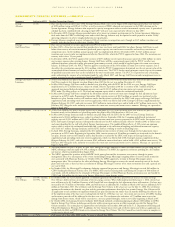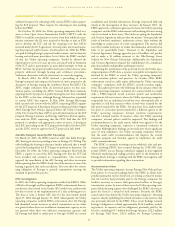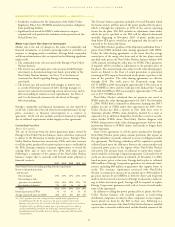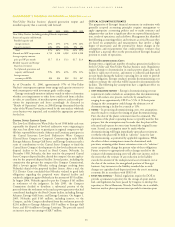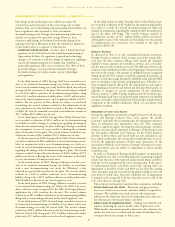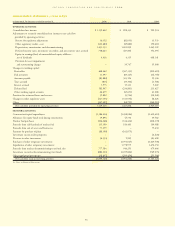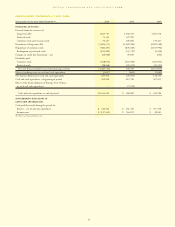Entergy 2006 Annual Report Download - page 61
Download and view the complete annual report
Please find page 61 of the 2006 Entergy annual report below. You can navigate through the pages in the report by either clicking on the pages listed below, or by using the keyword search tool below to find specific information within the annual report.
ENTERGY CORPORATION AND SUBSIDIARIES 2
2000066
fuel storage on the nuclear plant site, which can require the
construction and maintenance of dry cask storage sites or other
facilities. The costs of developing and maintaining these facilities can
have a significant effect (as much as 16% of estimated
decommissioning costs). Entergy’s decommissioning studies may
include cost estimates for spent fuel storage. However, these
estimates could change in the future based on the timing of the
opening of the Yucca Mountain facility, the schedule for shipments
to that facility when it is opened, or other factors.
■TECHNOLOGY AND REGULATION – To date, there is limited practical
experience in the United States with actual decommissioning of
large nuclear facilities. As experience is gained and technology
changes, cost estimates could also change. If regulations regarding
nuclear decommissioning were to change, this could have a
potentially significant effect on cost estimates. The effect of these
potential changes is not presently determinable. Entergy’s
decommissioning cost studies assume current technologies
and regulations.
In the third quarter of 2004, Entergy Gulf States recorded a revi-
sion to its estimated decommissioning cost liability in accordance
with a new decommissioning cost study for River Bend that reflected
an expected life extension for the plant. The revised estimate resulted
in a $116.8 million reduction in decommissioning liability, along
with a $31.3 million reduction in utility plant, a $40.1 million reduc-
tion in the related regulatory asset, and a regulatory liability of $17.7
million. For the portion of River Bend not subject to cost-based
ratemaking, the revised estimate resulted in the elimination of the
asset retirement cost that had been recorded at the time of adoption
of SFAS 143 with the remainder recorded as miscellaneous income of
$27.7 million ($17 million net-of-tax).
In the third quarter of 2004, Entergy’s Non-Utility Nuclear busi-
ness recorded a reduction of $20.3 million in its decommissioning
cost liability to reflect changes in assumptions regarding the timing of
when the decommissioning of a plant will begin. Entergy considered
the assumptions as part of recent studies evaluating the economic
effect of the plant in its region. The revised estimate resulted in mis-
cellaneous income of $20.3 million ($11.9 million net-of-tax).
In the first quarter of 2005, Entergy’s Non-Utility Nuclear business
recorded a reduction of $26.0 million in its decommissioning cost lia-
bility in conjunction with a new decommissioning cost study as a
result of revised decommissioning costs and changes in assumptions
regarding the timing of the decommissioning of a plant. The revised
estimate resulted in miscellaneous income of $26.0 million ($15.8
million net-of-tax), reflecting the excess of the reduction in the liabil-
ity over the amount of undepreciated assets.
In the second quarter of 2005, Entergy Louisiana recorded a revi-
sion to its estimated decommissioning cost liability in accordance
with a new decommissioning cost study for Waterford 3 that
reflected an expected life extension for the plant. The revised estimate
resulted in a $153.6 million reduction in its decommissioning
liability, along with a $49.2 million reduction in utility plant and a
$104.4 million reduction in the related regulatory asset.
In the third quarter of 2005, Entergy Arkansas recorded a revision
to its estimated decommissioning cost liability for ANO 2 in accor-
dance with the receipt of approval by the NRC of Entergy Arkansas’
application for a life extension for the unit. The revised estimate
resulted in an $87.2 million reduction in its decommissioning liability,
along with a corresponding reduction in the related regulatory asset.
In the third quarter of 2005, System Energy recorded a revision to
its estimated decommissioning cost liability in accordance with a new
decommissioning cost study for Grand Gulf. The revised estimate
resulted in a $41.4 million reduction in the decommissioning cost lia-
bility for Grand Gulf, along with a $39.7 million reduction in utility
plant and a $1.7 million reduction in the related regulatory asset.
In the third quarter of 2006, Entergy’s Non-Utility Nuclear busi-
ness recorded a reduction of $27 million in decommissioning liability
for a plant as a result of a revised decommissioning cost study and
changes in assumptions regarding the timing of when decommission-
ing of the plant will begin. The revised estimate resulted in
miscellaneous income of $27 million ($16.6 million net-of-tax),
reflecting the excess of the reduction in the liability over the amount
of undepreciated asset retirement cost recorded at the time of
adoption of SFAS 143.
UNBILLED REVENUE
As discussed in Note 1 to the consolidated financial statements,
Entergy records an estimate of the revenues earned for energy deliv-
ered since the latest customer billing. Each month the estimated
unbilled revenue amounts are recorded as revenue and a receivable,
and the prior month’s estimate is reversed. The difference between the
estimate of the unbilled receivable at the beginning of the period and
the end of the period is the amount of unbilled revenue recognized
during the period. The estimate recorded is primarily based upon an
estimate of customer usage during the unbilled period and the billed
price to customers in that month, including fuel price. Therefore, rev-
enue recognized may be affected by the estimated price and usage at
the beginning and end of each period and fuel price fluctuations, in
addition to changes in certain components of the calculation.
Effective January 1, 2006, Entergy Louisiana and the Louisiana por-
tion of Entergy Gulf States reclassified the fuel component of unbilled
accounts receivable to deferred fuel and will no longer include the fuel
component in the unbilled calculation, which is in accordance with
regulatory treatment.
IMPAIRMENT OF LONG-LIVED ASSETS
Entergy has significant investments in long-lived assets in all of its seg-
ments, and Entergy evaluates these assets against the market
economics and under the accounting rules for impairment whenever
there are indications that impairments may exist. This evaluation
involves a significant degree of estimation and uncertainty, and these
estimates are particularly important in Entergy’s Utility business and
the non-nuclear wholesale assets business. In the Utility business,
portions of River Bend and Grand Gulf are not included in rate
base, which could reduce the revenue that would otherwise be recov-
ered for the applicable portions of those units’ generation. In the
non-nuclear wholesale assets business, Entergy’s investments in mer-
chant generation assets are subject to impairment if adverse market
conditions arise.
In order to determine if Entergy should recognize an impairment
of a long-lived asset that is to be held and used, accounting standards
require that the sum of the expected undiscounted future cash flows
from the asset be compared to the asset’s carrying value. If the expect-
ed undiscounted future cash flows exceed the carrying value, no
impairment is recorded; if such cash flows are less than the carrying
value, Entergy is required to record an impairment charge to write the
asset down to its fair value. If an asset is held for sale, an impairment
is required to be recognized if the fair value (less costs to sell) of the
asset is less than its carrying value.
These estimates are based on a number of key assumptions, including:
■FUTURE POWER AND FUEL PRICES – Electricity and gas prices have
been very volatile in recent years, and this volatility is expected to
continue. This volatility necessarily increases the imprecision
inherent in the long-term forecasts of commodity prices that are a
key determinant of estimated future cash flows.
■MARKET VALUE OF GENERATION ASSETS – Valuing assets held for sale
requires estimating the current market value of generation assets.
While market transactions provide evidence for this valuation, the
market for such assets is volatile and the value of individual assets
is impacted by factors unique to those assets.
MANAGEMENT’S FINANCIAL DISCUSSION and ANALYSIS continued
45




